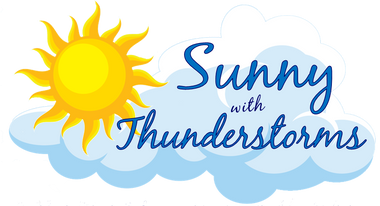Positioning Your Bird House

If you want to be successful at attracting birds to your yard, you can’t just buy a bird house and put it anywhere. Birds are particular to the house's construction, size, entrance and where the bird house is placed. Buy the right type house for the birds that you want to attract, then place them properly, and you’ll not only have better luck attracting birds, but will be providing them with a safe home.
Check out Sunny with Thunderstorms' collection of bird houses here.
Follow these tips:
Situate your bird house so it faces East to keep it warm.
In nearly all climates, having your birdhouse face East is best for the birds. An East-facing bird house will catch the first rays of morning sun, warming the birds after a chilly night. Hot afternoon rays of sun coming from the west will hit the closed back of the birdhouse and not overheat the birds.

If East isn’t a possibility due to the location of your house or yard, facing the bird house to the South is the second-best option since South-facing bird houses will receive more sunlight than houses that face North. Also, orienting them facing away from prevailing winds will provide the inhabitants more protection in bad weather.
Point the bird house’s entrance so it faces a food source for fledglings.
When the birds’ eggs hatch and the young emerge from the nest, they’ll need to find food. So, point the front of the bird house towards an open area that borders on bushes, shrubs, and trees where the young birds can find food. Ideally, potential food sources should be less than 40 feet away from the bird house.
Locate the bird house away from bird feeders and baths.
Bird feeders and bird baths both tend to draw in predators, which quickly learn that the congregated birds make a great food source. To protect the bird eggs and fledglings from predators (e.g., gray squirrels), hang bird houses at least 30 feet away from feeders or baths.
It’s possible to have both a bird feeder or bath and a bird house, as long as you’re smart about where you locate them. For example, try setting the feeder on your front porch and hanging the birdhouse on a tree in your backyard.
Hang to bird house from 5 to 30 feet above the ground.
If the bird house is mounted too low, it may be vulnerable to predators; too high, and many species of bird won’t want to live in it. Smaller birds often favor lower nests. For example, if you’re hoping to have wrens, chickadees, or nuthatches

nest in your bird house, hang the house at exactly 5 feet. – See the recommendations below for certain heights for a few common birds.
Space multiple bird houses out by at least 15 ft.
While some bird species don’t mind having multiple nests close together, other species will refuse to use a bird house if it’s too near another nest. To avoid this problem, hang multiple bird houses about 15–20 feet away from one another. To achieve this, try to hang the houses on multiple types of surfaces. For example, hang 1 on a pole in your front yard, 2 more on opposite sides of your home, and a final 1 on a brick wall in your backyard.
Bird House Height Recommendations for several common birds:
Bluebird: 3-6 feet
Purple Martin: 10-15 feet
American Kestrel: 10-30 feet
Eastern Screech Owl: 10-30 feet
Great Crested Flycatcher: 3-20 feet
Northern Flicker: 6-30 feet
Tree Swallow: 5-15 feet
Tufted Titmouse: 5-15 feet
Black-capped Chickadee: 5-15 feet
White-breasted Nuthatch: 5-20 feet
Carolina Wren: 5-10 feet
Prothonotary Warbler: 2-12 feet
Keep in mind that there are more considerations in addition to height for attracting birds to your bird houses, including construction materials, hole dimensions and direction, entrance features, nesting material, surrounding landscape and possibly even unique requirements of individual species.
